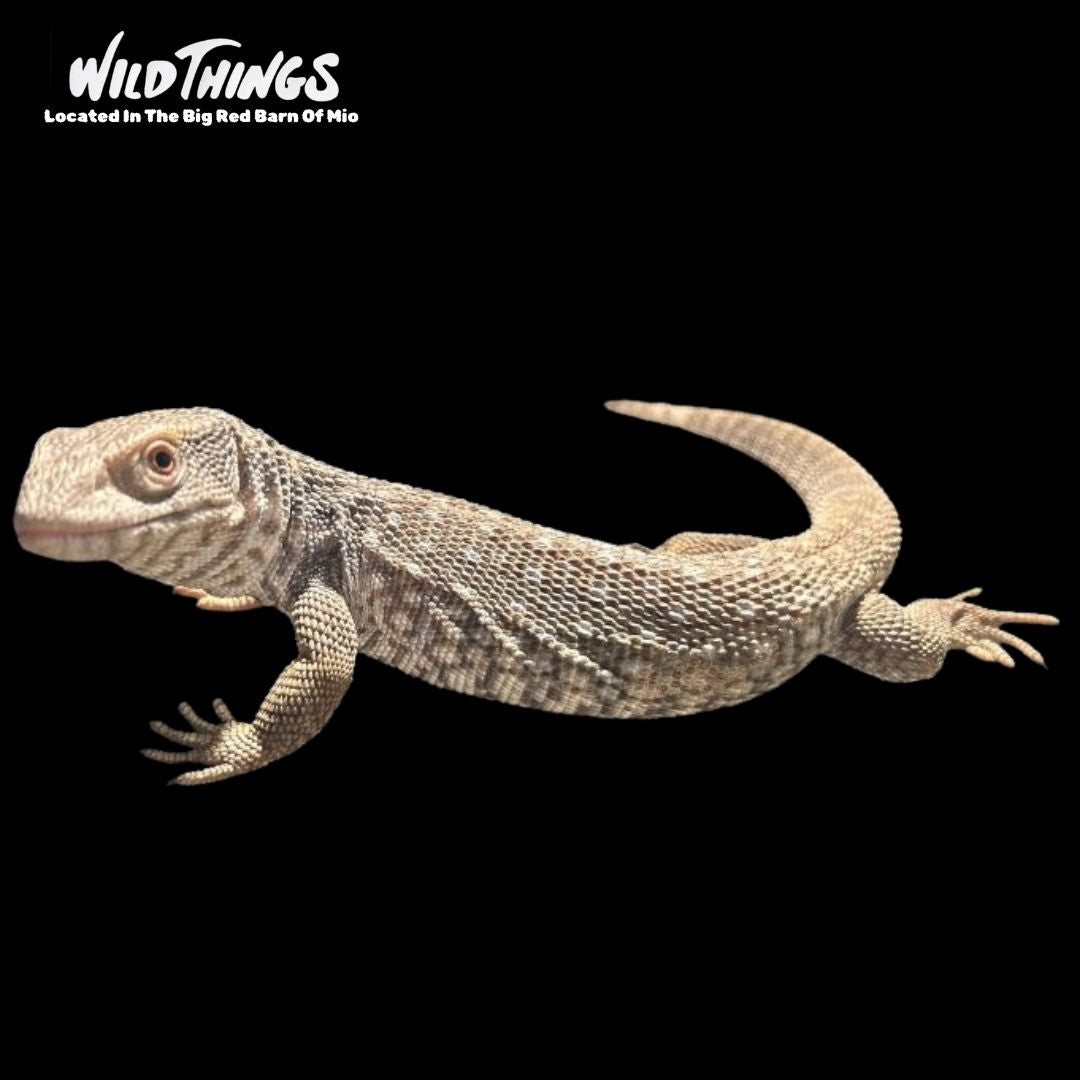AuSable River Outdoors
Savanah Monitor
Savanah Monitor
Couldn't load pickup availability
Species: Savanah Monitor
Scientific Name: Varanus exanthematicus
Origin: In countries such as Benin, Burkina Faso, Cameroon, Central African Republic, Chad, DR Congo, Cote d'Ivoire, Ethiopia, and Gambia.
Lifespan: 10 to 25 years
Size: 3-4 feet in length
Enclosure Type: Savannah Monitors can be kept in a 55 gallon aquarium as a juvenile but it is recommended to upgrade to a custom enclosure rather quickly. The enclosure can be made of wood, acrylic and glass. Avoid using screen as their nails will damage it quickly if they can reach it. Ensure that the enclosure is escape proof as savannah monitors are extremely good diggers and escape artists. The lid should have a lock at all times to ensure your savannah monitor does not escape. Also make sure there is plenty of ventilation.
Enclosure Size: The enclosure will need to be at least twice the lizard's length at adulthood. An adult requires an 8-foot long by 4-foot wide cage. It should be at least 3 feet high.
Substrate: For savannah monitors, a deep substrate of at least 18-24 inches, consisting of a mix of soil, sand, and possibly coco fiber, is crucial for their burrowing behavior and natural habitat needs.
• Topsoil: Provides a good base for burrowing and moisture retention.
• Play Sand: Helps with drainage and burrow stability.
• Coco Fiber: Helps retain moisture and create a more natural environment
Avoid:
• Fine or Beach Sand: These types of sand can be too fine and compact, making it difficult for monitors to dig and potentially causing impaction.
• Gravel or Corncob: These are also not recommended due to the risk of impaction.
Décor:
• Hides: Provide plenty of secure hides, including large rocks, logs, and bushes, to allow them to feel safe and secure.
• Climbing Opportunities: Include branches, cork bark, and other climbing structures to encourage natural behaviors.
• Natural Elements: Incorporate natural elements like rocks, branches, and plants (both real and fake) to mimic their natural environment.
• Textured Surfaces: Offer a variety of textures for them to explore, such as slate, dirt, rocks, moss, leaves, bark, and plants. Rocks also help to keep monitors nails filed so they do not overgrow.
Water: Savannah monitors need a large water dish or tub to drink from and submerge themselves in, as they can stay underwater for extended periods, large water tubs will also keep a humid environment (45-60% humidity).
Temperature: Proper heating is a critical component in the care of your Savannah monitor, allowing efficient metabolism, appropriate growth, and proper immune system function. These lizards thermoregulate themselves based on body needs and require a temperature gradient on both a horizontal and vertical plane. Avoid electric reptile “hot rocks” as these can be associated with serious burns.
• Strive for 85-90°F (29-32°C) For Daytime Temperatures
• Basking areas should be 94-100°F (34-38°C). Combine an undertank-heating pad (on the warm side) with a spotlight or white incandescent bulb in the basking area to achieve the correct temperature gradient.
• Temperature should drop to 74-78°F (23-26°C) at night. Use a nocturnal reptile bulb or red light if nighttime temperatures drop too low so as not to disturb your monitor’s sleeping patterns.
• Place thermometers on the cool side of the cage, the warm side and near the basking area to monitor temperature.
Humidity: Savannah monitors require moderate humidity between 40%-50%. You can achieve this by having a moist hide in their enclosure, and a water dish large enough for the lizard to fully submerge in. You will want to soak your monitor in lukewarm water once or twice a week, to ensure proper hydration and encourage shedding
Lighting: Savannah monitors are diurnal, meaning they are most active during the day, so a proper lighting schedule is crucial. Aim for a 10-12 hour light cycle, with lights turned off at night to maintain a natural day/night cycle. UVB and UVA Lighting: Savannah monitors need both UVB and UVA lighting for proper health and digestion.
• UVB: Essential for vitamin D3 synthesis, which is needed for calcium absorption.
• UVA: Helps with the lizard's sense of vision and general well-being
Type Of Diet: Savanah Monitors are insectivores, which means that they need a varied diet of insects to get the right nutrition.
Types Of Food: Crickets, superworms, king mealworms, silkworms, grasshoppers, cockroaches, as well as crayfish and other low-fat foods like cooked egg whites. Waxworms should only be offered occasionally, as they are high in fat. Pre-killed mice or rats can be offered, but only occasionally to reduce the risk of obesity.
Feeding Schedule: A Savannah monitor should be fed daily when young (hatchlings and juveniles), gradually reducing feeding frequency to 2-3 times per week for adults to prevent obesity, with the focus on larger meals rather than constant small feedings; always monitor your lizard's body condition to adjust feeding frequency accordingly.
Supplements: Dust diet with a calcium carbonate or calcium gluconate supplement once weekly. Calcium supplements should be devoid or low in phosphorus with a minimum calcium: phosphorus ratio of 2:1. Avoid products containing Vitamin D as this can lead to toxicity. A general vitamin/mineral supplement may also be offered once weekly.
Share

